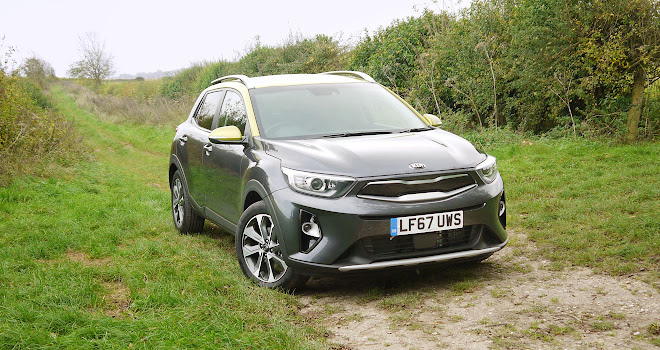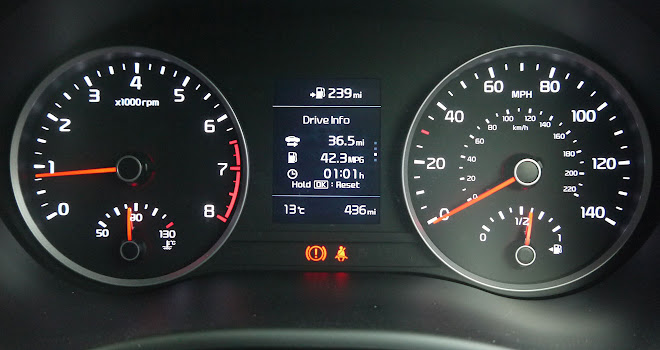
Rating: stars
Good: Neat styling, comfortable, well equipped
Bad: Disappointing economy from the 1.0 petrol engine
Price: £16,295 to £20,495 before options
Kia has chosen a strange name for its new compact crossover, though I suppose Stonic is not quite as odd as Cee-apostrophe-d. No doubt the sound will stick in the ears a little less as time passes.
A fairly handsome looking thing, the Stonic is effectively a taller version of the Rio supermini. It shares some Rio styling, though the crossover is clearly not just a supermini on stilts. It seems and indeed actually is a fair bit bigger – with an extra 7cm in length, 3.5cm in width and 7cm in height over the Rio. Part of the additional height is due to a 4.2cm suspension lift to increase ground clearance.
Rio and Stonic do have a lot in common under the skin, however, highlighted by their shared 258cm wheelbase.

The Stonic has its own styling quirks too, including a kinked rather than straight sill, and a more pronounced upward kick at the back of its side windows compared to the Rio, giving the Stonic a dash of Picanto in this area.
Contrasting paint creates a rollover bar effect, looping over the top of the car at the rear and chopping the coloured roof into separate sections. This styling quirk was previewed by Kia’s Provo concept car in 2013.

Surprisingly, Kia’s Stonic doesn’t share much with the new Kona SUV from sister company Hyundai, even though the two cars are roughly the same size and shape. Kona sits on a tough four-wheel-drive platform, while Stonic is a strictly front-wheel-drive car and slightly leaner and lighter as a result.
“They are completely different animals,” said Hyundai-Kia chief design officer Peter Schreyer when I asked him about Kona and Stonic at the Frankfurt motor show in September. “They don’t really fish in the same pond. They were also developed totally independently, basically not knowing about each other.”

In the Stonic’s cabin, I spotted plenty of parts shared with the Rio but that’s not a bad thing. The two top-spec First Edition cars I sampled proved comfortable, well equipped and beautifully put together. An annoying squeak in the second car I drove turned out to be two fat bottles of water rubbing together in the centre-console cupholders.
Prices for the Stonic fall between £16,295 and £20,495 before options. As with most cars in this bracket, you can look around the cabin and see where cash has been splashed and where pennies have been scrimped. Delightful pieces of cool metal trim on the handbrake button, gearstick and door release levers raise the ambience, whereas the swathe of cheap looking hard plastic across the top of the dashboard does not. On balance, however, I think Kia has achieved a pretty good result.

I found the front seats very comfortable and easy to adjust, and there’s also lots of wheel adjustment to get your elbows properly aligned. Alas the rear seats don’t slide fore and aft as they do in some rival supermini crossovers.
All-round vision is excellent, with slim screen pillars at an angle that gave me good sight lines on the approaches to roundabouts.
Just two trim levels are available from launch: “2”, normally a mid-range Kia spec, and First Edition, a top-of-the-range version. Somewhat surprisingly, there’s no option for a contrast roof with the 2 spec. It’s also disappointing to see that Kia’s Autonomous Emergency Braking (AEB) is not fitted as standard to the 2 trim level. The First Edition gets this collision avoidance system as standard, contributing to a drop in insurance group from 14 to 12.

A seven-inch touchscreen thankfully doesn’t control the Stonic’s cabin ventilation – physical controls mounted below make it easy to grapple with the heating on the move.
In First Edition cars, the screen provides TomTom navigation with traffic data and a reversing camera view. DAB radio, Apple Carplay and Android Auto are provided across the board. Hooking up my iPhone to the Stonic via Bluetooth proved quick and simple, and hands-free calling on the move worked without a hitch.
When ordering a First Edition car, it’s worth remembering that the roof colour also makes a potentially eye watering appearance inside. I loved the zesty result – including matching stitching on the steering wheel – but orange or lime in the cabin might not be to everyone’s taste.

I tried two flavours of First Edition – the car with a lime green roof has a 1.0-litre T-GDi petrol engine, while the orange and grey car has a 1.6-litre CRDi diesel engine. Both featured a smooth shifting six-speed manual gearbox; no automatic transmission is available yet.
Both engines include quick and efficient stop-start technology and are rated at 115g/km of CO2 for the petrol and 109g/km for the diesel. The diesel engine is 70kg heavier, pushing overall weight up to about 1.3 tonnes.
The 998cc, three-cylinder petrol engine offers up to 118bhp and 171Nm of torque, and can propel the Stonic to 60mph in 9.9 seconds. The four-cylinder, 1,582cc diesel engine provides up to 108bhp and a peak of 260Nm, getting to 60mph in 10.9 seconds. There’s also a cheaper and less high-tech 1.4-litre petrol engine rated at 98bhp, 133Nm and 125g/km, which I didn’t try.

The diesel Stonic obliged with better than 58mpg during my test drive, whereas I failed to get any more than 43mpg out of the 1.0 petrol car. I confess that I didn’t pay a lot of attention to the car’s gearshift hints after a while, because with six gears to play with the car always seemed to think I was in the wrong one. The shift hints could easily have been replaced by a tut-tut sound every time I swapped cogs.
The Stonic is not a particularly sporty car to drive, which I’d class as a good thing. It lopes along softly over bumps and leans generously through corners but manages to inspire confidence in the process. With a bit of bonnet in view I gained a good sense of the car’s width through tight gaps and the steering is surprisingly crisp and responsive without the vagueness that sometimes crops up in tall crossovers.

Neither the diesel nor the petrol Stonic is particularly quiet – the petrol growls and howls while the diesel drones and groans (and produces more noticeable vibration). Of the two I prefer the petrol soundtrack, not least because the three-cylinder car is £800 cheaper than the diesel.
If the 15mpg gap I saw between diesel and petrol is typical, it would take about 25,000 miles for the diesel to save you £800 at the pumps, at today’s prices per litre. The extra headline cost will also lead to higher monthly payments for personal contract customers who choose the diesel, meaning they won’t actually save money through improved economy unless they rack up higher than average mileages.

There is also the ongoing diesel backlash to consider, with petrol cars generally perceived as cleaner in terms of harmful pollutants like NOx. Kia itself expects petrol Stonics to outsell diesel versions two to one.
Overall I found the Stonic an appealing little thing with good looks and a comfortable cabin on its side. Disappointing economy from the petrol engine is my only real grumble.




